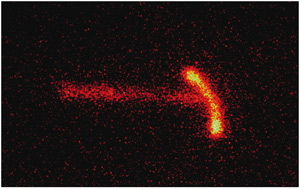In work that harks back to the early days of nuclear physics, an international team of researchers at Michigan State University’s National Superconducting Cyclotron Laboratory (NSCL) has used a novel detector incorporating a CCD camera to record optically the tracks of charged particles emitted in the two-proton decay of iron-45 (45Fe). The technique has allowed the first measurement of correlations between the two protons, demonstrating that the process is indeed a three-body decay. Besides shedding light on a novel form of radioactive decay, the technique could lead to additional discoveries about short-lived rare isotopes, which may hold the key to understanding processes inside neutron stars and determining the limits of nuclear existence.

Although it is more than 100 years since Henri Becquerel opened the door to nuclear physics with his discovery of radioactivity, there are still open questions that continue to nag experimentalists. One such example is the mechanism underlying the two-proton emission of neutron-deficient nuclei, first observed in the 1980s.
Now Krzysztof Miernik and colleagues from Poland, Russia and the US have taken several steps towards an answer, by peering closely at the radioactive decay of a rare iron isotope at the edge of the known nuclear map (Miernik et al. 2007). The researchers set out to obtain a better understanding of two-proton emission from 45Fe, which has a nucleus of 26 protons and 19 neutrons; in comparison, the stable form of iron most abundant on Earth has 30 neutrons. One possibility was that the neutron-deficient 45Fe might occasionally release a diproton – an energetically correlated pair of protons. It was also possible that the two protons, whether emitted in quick succession or simultaneously, were unlinked.
The experiment’s key device was the novel imaging detector built by Marek Pfutzner and colleagues from Warsaw University – the Optical Time Projection Chamber (OPTC). This consists of a front-end gas chamber that accepts and slows down rare isotopes in a beam from the NSCL Coupled Cyclotron Facility. Electrons from the ionized tracks drift in a uniform electric field to a double amplification structure, where UV emission occurs. A luminescent foil converts these photons to optical wavelengths, for detection by a CCD camera. In this way, the camera records the projection of the particle tracks on the luminescent foil. A photomultiplier tube also detects the photons from the foil to provide information on the drift time of the electrons, and hence the third dimension, normal to the plane of the CCD.
Analysis of these images ruled out the proposed diproton emission and indicated that the correlations between emitted protons are best described by a three-body decay. A theory of this process has been described by Leonid Grigorenko, a physicist at JINR, and a co-author of the paper.
The experiment itself recalls the early days of experimental nuclear physics in which visual information served as the raw data, with tracks recorded in photographic emulsion. Indeed, this was the process that lay behind Becquerel’s discovery of radioactivity. The new result may represent the first time in modern nuclear physics that fundamental information about radioactive decays has been captured in a camera image and in a digital format. Usually, nuclear physics experiments provide digitized data and numerical information of various types, but not images.





